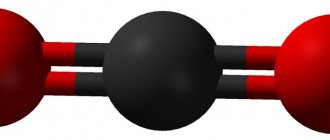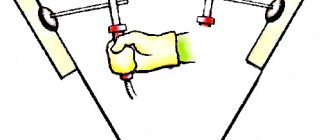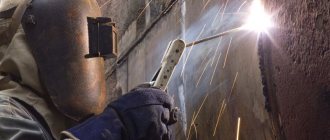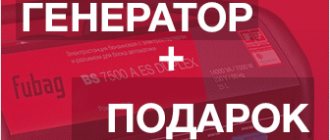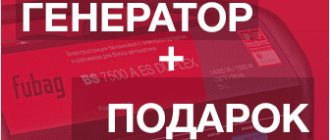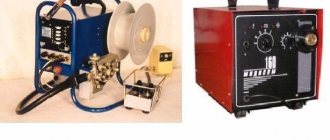Home / Welding technique
Back
Reading time: 2 min
1
3024
Currently, semi-automatic welding using carbon dioxide is used by both specialists and novice welders.
In this article you will learn a lot of useful information about working with carbon dioxide, its advantages, such as protecting the weld from the negative effects of particles in the air, improving the quality of the work performed, and more.
- What is welding with a semi-automatic welding machine in a CO2 environment?
- Advantages of carbon dioxide welding
- Components for carbon dioxide welding
- conclusions
What is semi-automatic welding in a carbon dioxide environment
The operating principle of this method is as follows: carbon dioxide enters the welding zone, which, under the influence of the high temperature of the welding arc, breaks down into two components - carbon monoxide (CO) and oxygen (O2).
The chemical formula of the process is 2СО2=2СО+О2.
This reaction is oxidative. Carbon monoxide (CO) perfectly protects the welding zone from the effects of ambient air, but the action of carbon dioxide and oxygen leads to the burning of carbon and alloying components from the metal, which in turn leads to the appearance of pores in the weld.
To neutralize carbon dioxide, a special welding wire of the Sv-08GS, Sv-08G2S type, containing manganese and silicon, is used. They are more active than iron, and enter into the oxidation reaction first, preventing the oxidation of carbon and iron. During the welding process in shielding gas, manganese and silicon form a low-melting compound and are brought to the surface in the form of slag.
Features of welding in carbon dioxide
Compared with other welding methods, mechanized welding in a carbon dioxide environment is very simple and suitable even for beginners; it has the following features:
- Carbon dioxide welding of metal products is carried out using reverse polarity direct current. This allows for improved stability of the welding arc, reducing the possibility of various deformations. The electrode in the form of a wire is not consumed by splashing.
- Straight polarity is used when surfacing metal. The deposition coefficient in this case for semi-automatic welding is significantly higher (1.6-1.8 times) than with current with reverse polarity.
- AC welding is possible using an oscillator.
We recommend! Welding aluminum with argon for beginners
Specifics of technology
Welding in a carbon dioxide atmosphere is a type of electric arc .
The constant discharge of the electric arc releases a large amount of thermal energy, which heats and melts the metal of the workpiece. The current flows through the workpiece, the air gap and the infusible tungsten electrode. The welding material in the form of wire is fed into the working area separately; it does not serve as a conductor. Feeding is carried out at a constant speed by a feed mechanism built into the semi-automatic welding machine.
In order to protect the weld pool from the effects of oxygen and hydrogen in the air, as well as water vapor, a protective atmosphere consisting of carbon dioxide is supplied to the working area. Its cloud displaces air and prevents unwanted chemical reactions
Modes of semi-automatic welding in shielding gases
Depending on the thickness of the metals being welded, optimal welding modes in carbon dioxide are selected and welding equipment is adjusted. Table 1 shows the parameters that influence the choice of welding modes.
When analyzing the table data, important points should be noted:
- The penetration depth will increase with increasing welding current.
- Arc voltage is directly related to arc length. As it increases, the voltage also increases, and therefore the width and depth of penetration;
- The wire feed speed must ensure stable arc burning at the given voltage parameters;
- Electrode stickout ensures the stability of the arc burning process; as it increases, the properties of the arc and, accordingly, the quality of the weld deteriorate. At short overhangs, the welding process is poorly visible through the welding mask, and the contact tip often burns out.
- The overhang is selected depending on the diameter of the electrode wire used.
Now that we have understood the semi-automatic welding modes, let’s begin preparation and further work
General rules of welding
As in any business, semi-automatic welding has a base that the welder must know.
- When welding parts with a thickness of more than 3 mm, a gap of 1-2 mm is made between them. This is necessary for complete penetration of the metal. If there is no gap, the seam will be superficial;
- When heated, the metal pulls; to ensure uniformity of the gap, tacks are made on the top and bottom of the workpiece. If the penetration length is large, the number of tacks increases;
- you need to ensure that the seam is evenly deposited on both workpieces.
These are simple rules to remember.
Preparing for work
Before you begin, you should familiarize yourself with the controls that are located on the front panel:
- Welding current switch - allows you to set a weak current, which is suitable for thin metals and up to a stronger one (often 6), which is suitable only for thick metals.
- Wire feed speed is controlled by a separate switch
- Some semi-automatic machines are equipped with on-timers for more convenient spot welding.
- Hole for welding gun
Before connecting the device to power, make sure that the network has the appropriate voltage and power for the semiautomatic device.
Setting up and connecting welding equipment
- Insert the welding wire; its feed mechanism is located under the cover. Check the rollers that feed the wire into the machine, the guide hose and the electrode of the welding gun. They must be identical to the wire type and size. To use a different size wire, you need to change or turn over the drive roller. The size marking is cut into the side of the roller. Reels can have different mounting sizes. To do this, use special adapters. Before you begin the adjustment, you need to place the wire in the appropriate groove, then engage the adjustment roller. When pressing the roller, remember not to press too lightly (the wire will slip out a little) or too much (the wire will be deformed).
- Extend the feed hose to its full length, remove the nozzles and tip, then press and hold the button on the torch until the wire automatically comes out 10-15 cm. After this, you can put the tip and nozzle in place.
- Connect the protective gas cylinder to the device using a hose through the reducer and secure with clamps.
We recommend! How to weld aluminum with an inverter using an electrode
The device is now ready for use.
Preparing metals for welding in CO2
When welding very thin plates of low-alloy or carbon steel (0.5mm-1mm), it is worth flanging the edges. Without flanging, the space between the sheets during welding should not be more than 0.5mm. If the thickness of the sheets exceeds 1mm, then there is no need to do flanging, but the distance between the sheets should not exceed 1mm.
Before welding metals, it is worth removing unnecessary elements from them, such as oil, paint, dirt, etc. It is also advisable to remove rust.
Refill features
A carbon dioxide cylinder for a semi-automatic machine is charged using two methods:
- bypassing from the storage tank through the reducer and flow meter into the refilled cylinder;
- pumping into a refillable cylinder using a compressor.
Regardless of the filling method, it is important to accurately determine the empty weight of the cylinder . By weighing the cylinder after filling, you can accurately determine the amount of CO2 injected.
Filling cylinders with carbon monoxide, unlike acetylene or oxygen, does not require extraordinary precautions. However, one cannot relax: in the event of a massive leak, carbon dioxide forms an atmosphere unsuitable for breathing. Therefore, it is necessary to carefully check the condition of cylinders, fittings and hoses for mechanical damage.
When refueling using the “cylinder to cylinder” method, it is recommended to turn the cylinder from which you refuel upside down and monitor its temperature.
How to properly weld with a semi-automatic machine
After you have chosen the desired feed speed and amperage, prepared the products, you need to adjust the flow of carbon dioxide and only after 30 seconds excite the arc and start welding so that the gas squeezes out the air from the hoses and channels of the welding torch.
The main thing is not to rush and before welding, be sure to practice on an unnecessary piece of metal, this way the welding will be of better quality. And only after all this you need to start the main work.
Welding methods:
- Angle forward, moving the burner from right to left. The metal melts less, the weld bead is wide. Used when welding thin metal:
- Angled backwards, the burner moves from left to right. The penetration depth is greater, the seam width is reduced.
Step by step welding process:
- Tilt the burner 5° from the vertical axis
- Start moving the electrode by analogy with manual welding, watch for good metal penetration and the formation of a high-quality bead. To avoid the risk of cracking, it is recommended to weld the first layer at low current.
- We complete the seam by filling the crater with metal.
- Stop the wire feed and turn off the current.
Gas continues to be supplied to the welded crater until the metal hardens.
In justified cases, regardless of the conditions of use of welded joints, welding can be done in a mixture with argon and with a carbon dioxide content of less than 50%, but not less than 15%.
We recommend! Do-it-yourself welding of polypropylene sheets
Carbon dioxide consumption during welding for semi-automatic welding machine
Gas consumption can vary greatly, but generally one cylinder is enough for 10-15 hours of continuous operation.
A standard cylinder holds up to 25 kilograms of carbon dioxide. Due to a chemical reaction, one kilogram is converted into 509 liters of gas. Gas consumption is also calculated based on the quality of the flux and weather conditions. According to tabular calculations, carbon dioxide consumption during welding can range from 5 to 60 liters per minute. The consumption is also affected by the characteristics of welding in carbon dioxide.
Semi-automatic welding with carbon dioxide: pros and cons
Since there are methods of welding in other shielding gases and welding mixtures, it is worth noting the advantages and disadvantages of welding in a CO2 environment
The advantages are the following:
- Ability to weld ultra-thin parts (up to 0.5 mm);
- More accurate welding;
- Safety;
- CO2 is much easier to buy than welding mixtures
Next up are the cons:
- Cleaning takes longer
- Inferior to protective gas mixtures
- Costs for filler materials are increasing
Welding thick metals
When welding workpieces thinner than 4 mm, chamfers are removed from the edges. This is done to obtain deep penetration. The burner is not driven in a straight line, but with slight oscillatory movements. For example, zigzag, spiral, back and forth, etc. This will make the seam deeper and wider.
Rules:
- a gap of 1-2 mm is made between the parts;
- the width of the welding seam should be equal to the thickness of the workpiece (approximately), for example, if 2 parts with a thickness of 6 mm are being welded, the seam should extend 3 mm onto each of them;
If the thickness of the workpieces is more than 5 mm, it may be necessary to cook in several passes. The first seam is made in the center, the second and third - above and below the first seam.
In practice, it is not difficult to understand how to operate a semi-automatic machine. You can get acceptable results already on the first day of training. The main thing is not to be afraid to experiment and remember that the semi-automatic settings are individual for each welder.
Safety precautions. Carbon monoxide danger
For additional safety, I advise you to purchase thick gloves and clothing, as well as a special “Chameleon” mask. Requirements regarding safety and industrial sanitation during welding work must be ensured by compliance with the conditions of GOST 12.1.004-76 and GOST 12.1.005-76.
Carbon monoxide (CO) is released during the welding process.
Concentrations greater than 0.1% are lethal.
It is dangerous because it is odorless and very toxic. The toxic effect consists of possible loss of consciousness by the welder due to blocking the processes of oxygen transport into cells.
